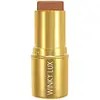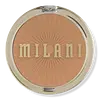What's inside
What's inside
 Key Ingredients
Key Ingredients

 Benefits
Benefits

 Concerns
Concerns

 Ingredients Side-by-side
Ingredients Side-by-side

Tridecyl Trimellitate
EmollientHydrogenated Polyisobutene
EmollientBis-Diglyceryl Polyacyladipate-2
EmollientMica
Cosmetic ColorantPentaerythrityl Tetraethylhexanoate
EmollientIsononyl Isononanoate
EmollientDiisostearyl Malate
EmollientOzokerite
Emulsion StabilisingCera Microcristallina
Emulsion StabilisingVinyl Dimethicone/Methicone Silsesquioxane Crosspolymer
Polyethylene
AbrasiveSilica
AbrasiveSilica Dimethyl Silylate
EmollientLimnanthes Alba Seed Oil
Skin ConditioningLecithin
EmollientTocopheryl Acetate
AntioxidantPhenoxyethanol
PreservativePhytosteryl/Octyldodecyl Lauroyl Glutamate
Skin ConditioningPolyhydroxystearic Acid
EmulsifyingAlumina
AbrasiveGlycerin
HumectantCI 77891
Cosmetic ColorantCI 77491
Cosmetic ColorantCI 77492
Cosmetic ColorantCI 77499
Cosmetic ColorantTridecyl Trimellitate, Hydrogenated Polyisobutene, Bis-Diglyceryl Polyacyladipate-2, Mica, Pentaerythrityl Tetraethylhexanoate, Isononyl Isononanoate, Diisostearyl Malate, Ozokerite, Cera Microcristallina, Vinyl Dimethicone/Methicone Silsesquioxane Crosspolymer, Polyethylene, Silica, Silica Dimethyl Silylate, Limnanthes Alba Seed Oil, Lecithin, Tocopheryl Acetate, Phenoxyethanol, Phytosteryl/Octyldodecyl Lauroyl Glutamate, Polyhydroxystearic Acid, Alumina, Glycerin, CI 77891, CI 77491, CI 77492, CI 77499
Talc
AbrasiveZea Mays Starch
AbsorbentZinc Stearate
Cosmetic ColorantDimethicone
EmollientMica
Cosmetic ColorantPentaerythrityl Tetraisostearate
EmollientOctyldodecyl Stearoyl Stearate
EmollientCaprylyl Glycol
EmollientSilica
AbrasiveHdi/Trimethylol Hexyllactone Crosspolymer
Nylon-12
Hexylene Glycol
EmulsifyingArgania Spinosa Kernel Oil
EmollientDiisostearyl Malate
EmollientLauroyl Lysine
Skin ConditioningCocos Nucifera Oil
MaskingGardenia Taitensis Flower
Skin ConditioningTocopherol
AntioxidantPhenoxyethanol
PreservativePotassium Sorbate
PreservativeAroma
CI 15850
Cosmetic ColorantCI 19140
Cosmetic ColorantIron Oxides
CI 77742
Cosmetic ColorantCI 77891
Cosmetic ColorantTalc, Zea Mays Starch, Zinc Stearate, Dimethicone, Mica, Pentaerythrityl Tetraisostearate, Octyldodecyl Stearoyl Stearate, Caprylyl Glycol, Silica, Hdi/Trimethylol Hexyllactone Crosspolymer, Nylon-12, Hexylene Glycol, Argania Spinosa Kernel Oil, Diisostearyl Malate, Lauroyl Lysine, Cocos Nucifera Oil, Gardenia Taitensis Flower, Tocopherol, Phenoxyethanol, Potassium Sorbate, Aroma, CI 15850, CI 19140, Iron Oxides, CI 77742, CI 77891
Ingredients Explained
These ingredients are found in both products.
Ingredients higher up in an ingredient list are typically present in a larger amount.
Ci 77891 is a white pigment from Titanium dioxide. It is naturally found in minerals such as rutile and ilmenite.
It's main function is to add a white color to cosmetics. It can also be mixed with other colors to create different shades.
Ci 77891 is commonly found in sunscreens due to its ability to block UV rays.
Learn more about CI 77891Diisostearyl Malate is an emollient and most often used in lip products. It comes from isostearyl alcohol, a fatty acid, and malic acid, an AHA.
As an emollient, Diisostearyl Malate helps create a thin film on your skin to trap moisture in. This helps keep your skin soft and smooth.
Mica is a naturally occurring mineral used to add shimmer and color in cosmetics. It can also help improve the texture of a product or give it an opaque, white/silver color.
Serecite is the name for very fine but ragged grains of mica.
This ingredient is often coated with metal oxides like titanium dioxide. Trace amounts of heavy metals may be found in mica, but these metals are not harmful in our personal products.
Mica has been used since prehistoric times throughout the world. Ancient Egyptian, Indian, Greek, Roman, Aztec, and Chinese civilizations have used mica.
Learn more about MicaPhenoxyethanol is a preservative that has germicide, antimicrobial, and aromatic properties. Studies show that phenoxyethanol can prevent microbial growth. By itself, it has a scent that is similar to that of a rose.
It's often used in formulations along with Caprylyl Glycol to preserve the shelf life of products.
Silica, also known as silicon dioxide, is a naturally occurring mineral. It is used as a fine, spherical, and porous powder in cosmetics.
Though it has exfoliant properties, the function of silica varies depending on the product.
The unique structure of silica enhances the spreadability and adds smoothness, making it a great texture enhancer.
It is also used as an active carrier, emulsifier, and mattifier due to its ability to absorb excess oil.
In some products, tiny microneedles called spicules are made from silica or hydrolyzed sponge. When you rub them in, they lightly polish away dead skin layers and enhance the penetration of active ingredients.
Learn more about Silica